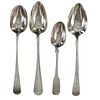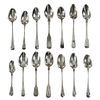For your consideration are fourteen sterling spoons made in England circa 1759-1837. The first spoon in this collection was made by Orlando Jackson in London circa 1772. James Young entered into a partnership with Orlando Jackson on the 17th of March 1774. Orlando Jackson has no record of apprenticeship or freedom however his first mark is entered in 1759. The spoon features a sterling construction and shows the makers mark and respective stamps on the back of the neck with the makers mark reading "IO". The next stamp is a lion passant indicating the quality of the sterling, followed by the London town mark and lastly a letter "R" indicating the year it was made (1772). The back of the handle shows initials as well reading "TH". The second spoon in this collection was made by David McDonald in Glasgow, Scotland circa 1837. The spoon features a sterling construction and shows initials on the top of the handle. The bottom of the neck shows the makers marks reading "D. McD" with a right facing kings head showing it was made under King William IV rule, an "S" indicating the year it was made (1837), a lion passant indicating the quality of the silver, and the Glasgow town mark. The third spoon in this collection was made by Bliss & Whittemore circa 1880-1900s. The spoon features a sterling construction and shows initials on the top of the handle reading, "MJ". The bottom of the handle shows the makers mark reading, "Bliss & Whittemore". The fourth spoon in this collection features a sterling construction and shows English stamps on the back of the neck along with the unidentified makers mark. The stamps show the makers mark reading, "VH 8", a lion passant indicating the quality of the silver, and left facing queens head and the letter "b" indicating the year it was made. The back of the handle reads "N=33". The fifth spoon in this collection shows no makers marks or stamps but features a sterling construction and small stamped designs on the outer edge of the the handle and neck. The sixth spoon in this collection was made by Thomas Wilkes Barker in London circa 1821. Thomas was the son of Christopher Barker of Pemberton Row, Gough Square, London Silversmith. The spoon shows initials on the handle reading, "GJ" while the back of the handle shows the makers mark and respective stamps. The makers mark reads, "TB", followed by a lion passant indicating the quality of the silver, the London town mark, the letter "f" showing what year it was made (1821) and a right facing kings head indicating it was made under King George IV. The seventh spoon in this collection was made by Richard Rugg in London circa 1790. The spoon shows initials on the top of the handle reading, "JJJ" and a name on the neck reading, "S. Parrott". The back of the spoon shows the makers mark reading "RR", a lion passant indicating the quality of the silver, the London town mark, the letter "P" showing what year it was made (1790) and a right facing kings head indicating it was made under King George III rule. The eighth spoon in this lot was made by Thomas Dicks in London circa 1803. The spoon features a sterling construction and shows stamped initials on the handle reading, "WHG" with the makers mark and other stamps on the back of the handle. The makers mark reads "TD", followed by a right facing kings head indicating it was made under King George III, the letter "H" showing the year it was made (1803), the London town mark and a lion passant indicating the quality of the silver. The ninth spoon in this collection was made by George Gray in London circa 1792. The spoon features a sterling construction and shows stamped initials on the top of the handle reading "R.R". The back of the handle shows stampings including the makers mark reading "GG" along with a right facing kings head indicating it was made under King George III, the letter "r" indicating it was made in the year 1792, the London town mar and a lion passant indicating the quality of the silver. The spoon shows a cut in the bowl. The tenth spoon in this collection was made by George Smith in London circa 1784. George Smith III was apprenticed to Thomas Chawner in 1765. The spoon featured initials on the handle at some point but has since been worn down. The back of the handle shows the respective stamps such as the makers mark reading "GS" in script, the London town mark, a lion passant indicating the quality of the silver and the letter "i" indicating the year it was made (1784). The handle shows a simple stamped design on the outer edge. The eleventh spoon in this collection was made by Thomas W. Barker in London circa 1821. The spoon features a sterling construction and shows initials stamped on the handle reading, "GJ". The back of the handle shows the makers mark and other stampings. The makers marks reads "TB" while the other stampings include a lion passant indicating the quality of the silver, the London town mark, the letter "f" showing what year it was made (1821) and a right facing kings head showing it was made under King George IV. The twelfth spoon in this collection was also made by Thomas Dicks in London circa 1803. The spoon features a sterling construction and shows stamped initials on the handle reading, "WHG" with the makers mark and other stamps on the back of the handle. The makers mark reads "TD", followed by a right facing kings head indicating it was made under King George III, the letter "H" showing the year it was made (1803), the London town mark and a lion passant indicating the quality of the silver. The thirteenth spoon in this collection was made by George Gray in London circa 1792. The spoon features a sterling construction and shows stamped initials on the top of the handle reading "R.R". The back of the handle shows stampings including the makers mark reading "GG" along with a right facing kings head indicating it was made under King George III, the letter "r" indicating it was made in the year 1792, the London town mark and a lion passant indicating the quality of the silver. The fourteenth and final spoon in this collection was made by Henry Sardet in London circa 1803. The spoon features a sterling construction but shows no designs. The bottom of the handle shows the makers mark and respective stamps. The makers mark reads "HS" while the other stamps include a right facing kings head indicating it was made under King George III rule, the letter "H" indicating the year it was made (1803), the London town mark and a lion passant indicating the quality of the silver. The spoons show good condition overall with some wear from use and their vintage age. Some spoons show a light patina to the silver but no obvious signs of damage are noted. The spoons measure from 6 7/8" L x 1 7/16" W to 9 1/16" L x 1 13/16" W. The collective weight of all the spoons is 802.6 grams.























